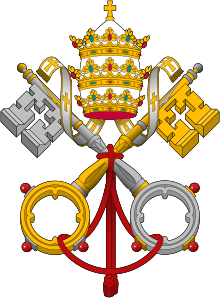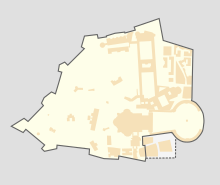 Emblem of Vatican City | |
Native name | Farmacia Vaticana |
|---|---|
| Company type | Pharmacy |
| Founded | 1874 |
| Headquarters | |
| Products | Drugs, Cosmetics |
Number of employees | 69 |
| Website | www |
The Vatican Pharmacy (Latin and Italian: Farmacia Vaticana) is the only pharmacy in the Vatican City, founded in 1874 by Eusebio Ludvig Fronmen, a Fatebenefratelli religious.[1] According to Vatican sources, it is the busiest pharmacy in the world, with 2,000 customers per day.[1] Half of those customers come from outside the Vatican for medicines that are not available in Italy or are difficult to find.[2]
The current director of the pharmacy is Binish Thomas Mulackal, a Fatebenefratelli monk.[1] Although the director of the pharmacy has always been a monk of that order, the staff pharmacists have been lay people for the past 30 years (7 religious and 53 laypeople in 2014).[3] The pharmacy is organized under the Directorate of Health Services, one of eight Vatican City directorates.[4]
Due to deeply relaxed or lack of regulations (self-regulation), the Vatican Pharmacy has one of the largest and most extensive stocks in Europe, carrying many American medicines considered experimental in Europe and vice versa. The pharmacy does not stock sexual health-related products nor Chinese traditional medicine.[1] It is popular among the citizens of Rome as it has more stock and prices up to 25% cheaper due to lack of taxes.
- ^ a b c d Glatz, Carol. 2008, May 23. "World's busiest pharmacy? Vatican drugstore offers cut-rate prices." Catholic News Service.
- ^ Cindy Wooden (20 August 2017). "Vatican pharmacy does booming business". Cruxnow.com. Retrieved 3 January 2018.
- ^ "Yearbook recounts life inside Vatican walls". Ucanews.com. 7 August 2015. Retrieved 3 January 2018.
- ^ d'Onorio, Joël-Benoît. Levillain, Philippe (ed.). 2002. "Vatican City State" in The Papacy: An Encyclopedia. Routledge. ISBN 0-415-92228-3. p. 1591.
